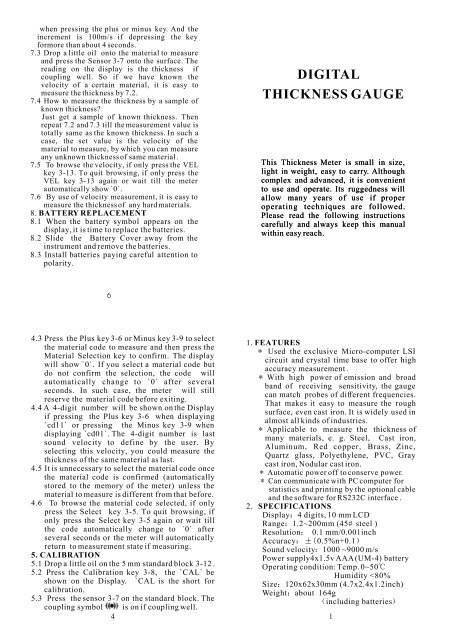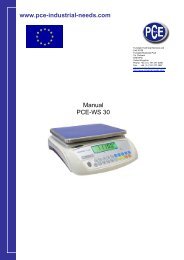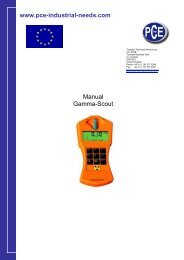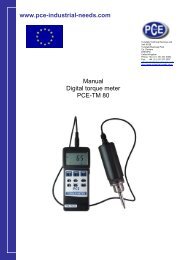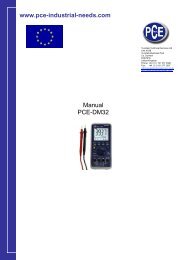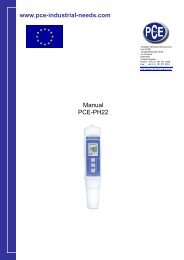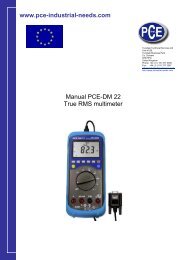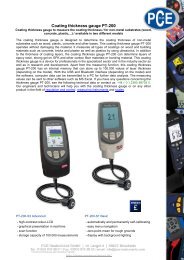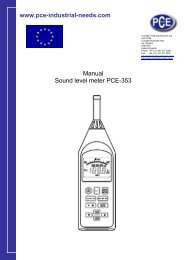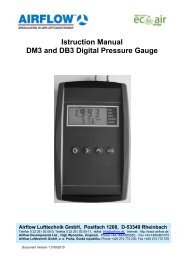DIGITAL THICKNESS GAUGE
DIGITAL THICKNESS GAUGE
DIGITAL THICKNESS GAUGE
Create successful ePaper yourself
Turn your PDF publications into a flip-book with our unique Google optimized e-Paper software.
when pressing the plus or minus key. And the<br />
increment is 100m/s if depressing the key<br />
formore than about 4 seconds.<br />
7.3 Drop a little oil onto the material to measure<br />
and press the Sensor 3-7 onto the surface. The<br />
reading on the display is the thickness if<br />
coupling well. So if we have known the<br />
velocity of a certain material, it is easy to<br />
measure the thickness by 7.2.<br />
7.4 How to measure the thickness by a sample of<br />
known thickness?<br />
Just get a sample of known thickness. Then<br />
repeat 7.2 and 7.3 till the measurement value is<br />
totally same as the known thickness. In such a<br />
case, the set value is the velocity of the<br />
material to measure, by which you can measure<br />
any unknown thickness of same material .<br />
7.5 To browse the velocity, if only press the VEL<br />
key 3-13. To quit browsing, if only press the<br />
VEL key 3-13 again or wait till the meter<br />
automatically show `0`.<br />
7.6 By use of velocity measurement, it is easy to<br />
measure the thickness of any hard materials.<br />
8. BATTERY REPLACEMENT<br />
8.1 When the battery symbol appears on the<br />
display, it is time to replace the batteries.<br />
8.2 Slide the Battery Cover away from the<br />
instrument and remove the batteries.<br />
8.3 Install batteries paying careful attention to<br />
polarity.<br />
<strong>DIGITAL</strong><br />
<strong>THICKNESS</strong> <strong>GAUGE</strong><br />
This Thickness Meter is small in size,<br />
light in weight, easy to carry. Although<br />
complex and advanced, it is convenient<br />
to use and operate. Its ruggedness will<br />
allow many years of use if proper<br />
operating techniques are followed.<br />
Please read the following instructions<br />
carefully and always keep this manual<br />
within easy reach.<br />
6<br />
4.3 Press the Plus key 3-6 or Minus key 3-9 to select<br />
the material code to measure and then press the<br />
Material Selection key to confirm. The display<br />
will show `0`. If you select a material code but<br />
do not confirm the selection, the code will<br />
automatically change to `0` after several<br />
seconds. In such case, the meter will still<br />
reserve the material code before exiting.<br />
4.4 A 4-digit number will be shown on the Display<br />
if pressing the Plus key 3-6 when displaying<br />
`cd11` or pressing the Minus key 3-9 when<br />
displaying `cd01`. The 4-digit number is last<br />
sound velocity to define by the user. By<br />
selecting this velocity, you could measure the<br />
thickness of the same material as last.<br />
4.5 It is unnecessary to select the material code once<br />
the material code is confirmed (automatically<br />
stored to the memory of the meter) unless the<br />
material to measure is different from that before.<br />
4.6 To browse the material code selected, if only<br />
press the Select key 3-5. To quit browsing, if<br />
only press the Select key 3-5 again or wait till<br />
the code automatically change to `0` after<br />
several seconds or the meter will automatically<br />
return to measurement state if measuring.<br />
5. CALIBRATION<br />
5.1 Drop a little oil on the 5 mm standard block 3-12 .<br />
5.2 Press the Calibration key 3-8, the `CAL` be<br />
shown on the Display. `CAL is the short for<br />
calibration.<br />
5.3 Press the sensor 3-7 on the standard block. The<br />
coupling symbol is on if coupling well.<br />
4<br />
1. FEATURES<br />
Used the exclusive Micro-computer LSI<br />
circuit and crystal time base to offer high<br />
accuracy measurement .<br />
With high power of emission and broad<br />
band of receiving sensitivity, the gauge<br />
can match probes of different frequencies.<br />
That makes it easy to measure the rough<br />
surface, even cast iron. It is widely used in<br />
almost all kinds of industries.<br />
Applicable to measure the thickness of<br />
many materials, e. g. Steel, Cast iron,<br />
Aluminum, Red copper, Brass, Zinc,<br />
Quartz glass, Polyethylene, PVC, Gray<br />
cast iron, Nodular cast iron.<br />
Automatic power off to conserve power.<br />
Can communicate with PC computer for<br />
statistics and printing by the optional cable<br />
and the software for RS232C interface .<br />
2 SPECIFICATIONS<br />
Display 4 digits, 10 mm LCD<br />
Range 1.2~200mm (45# steel )<br />
Resolution 0.1 mm/0.001inch<br />
Accuracy 0.5%n+0.1<br />
Sound velocity 1000 ~9000 m/s<br />
Power supply4x1.5v AAA (UM-4) battery<br />
Operating condition: Temp. 0~50<br />
Humidity
TABLE OF CONTENTS<br />
1. FEATURES ........................................1<br />
2. SPECIFICATIONS ............................1<br />
3. FRONT PANEL DESCRIPTIONS ...2<br />
4. MATERIAL SELECTION.................5<br />
5. CALIBRATION .................................4<br />
6. MEASURING PROCEDURE...........5<br />
7.MEASURING BY VELOCITY<br />
SETTING......................5<br />
8. BATTERY REPLACEMENT............6<br />
`5.0` mm (or `0.197` inch) and `CAL` will be<br />
shown on the Display in turn. When steady,<br />
Press CAL key 3-8 to confirm and then the<br />
unit return to the state of measurement.<br />
5.4 The calibration result will be auto-saved to<br />
the unit once confirmation. It is unnecessary<br />
to calibrate often unless you suspect the<br />
accuracy of measurement<br />
6. MEASURING PROCEDURE<br />
6.1 Press the power key 3-4 to turn on the unit.<br />
6.2 Press the mm/inch key 3-3 to select the right<br />
measurement unit.<br />
6.3 Press the Sensor 3-7 onto the material<br />
surface to measure on the premise that the<br />
material code selected is right. Be sure that<br />
coupling is well and the symbol is on. The<br />
reading on display is the measurement value.<br />
6.4 The reading is held till a new measurement<br />
value is coming. The last value is held on the<br />
display till the power is off.<br />
6.5 2 modes to turn off the power.<br />
Manual off at any time by pressing the power<br />
key or Auto power off after about 1 minutes<br />
from last key operation.<br />
7. MEASURING BY VELOCITY SETTING<br />
7.1 Press the VEL key 3-13 and the display<br />
shows the velocity set last time.<br />
7.2 How to measure its thickness by the velocity<br />
known ?<br />
The velocity can be changed by pressing the<br />
plus key or minus key to the value of known<br />
velocity. The increment is 10m/s every time<br />
5<br />
Accessory<br />
Carrying case<br />
1 pc.<br />
Operation manual 1 pc.<br />
Ultrasonic sensor ....................1 pc.<br />
3. FRONT PANEL DESCRIPTIONS<br />
3-7<br />
3-6<br />
3-14<br />
3-2<br />
3-11<br />
3-4<br />
3-8<br />
3-5<br />
3-3<br />
3-12<br />
3-13<br />
3-1<br />
3-9<br />
3-10<br />
3-1 Sensor plug<br />
3-2 Display<br />
3-3 mm/inch key<br />
3-4 Power key<br />
3-5 Material selection key<br />
3-6 Plus key<br />
3-7 Ultrasonic sensor<br />
3-8 Calibration key<br />
3-9 Minus key<br />
3-10 Battery Compartment/Cover<br />
3-11 Coupling indicator<br />
3-12 Standard block<br />
3-13 Velocity key<br />
3-14 RS232C interface<br />
4 MATERIAL SELECTION<br />
4.1 Press the power key 3-4 to turn on the unit.<br />
4.2 Press the Material Selection key 3-5 and<br />
the display 3-2 will show the code `cdxx`<br />
or `xxxx`. `cd` is the abbreviation for<br />
`code` and `xx` is one number among<br />
01~11. `xxxx` is a 4-digit number which is<br />
the sound velocity of material defined by<br />
the user.. The `cdxx`-material relationship<br />
is as follow.<br />
No. CODE Material<br />
1 cd01 Steel<br />
2 cd02 Cast iron<br />
3 cd03 Aluminum<br />
4 cd04 Red copper<br />
5 cd05 Brass<br />
6 cd06 Zinc<br />
7 cd07 Quartz glass<br />
8 cd08 Polyethylene<br />
9 cd09 PVC<br />
10 cd10 Gray cast iron<br />
11 cd11 Nodular cast iron<br />
12 xxxx Sound velocity<br />
2 3


